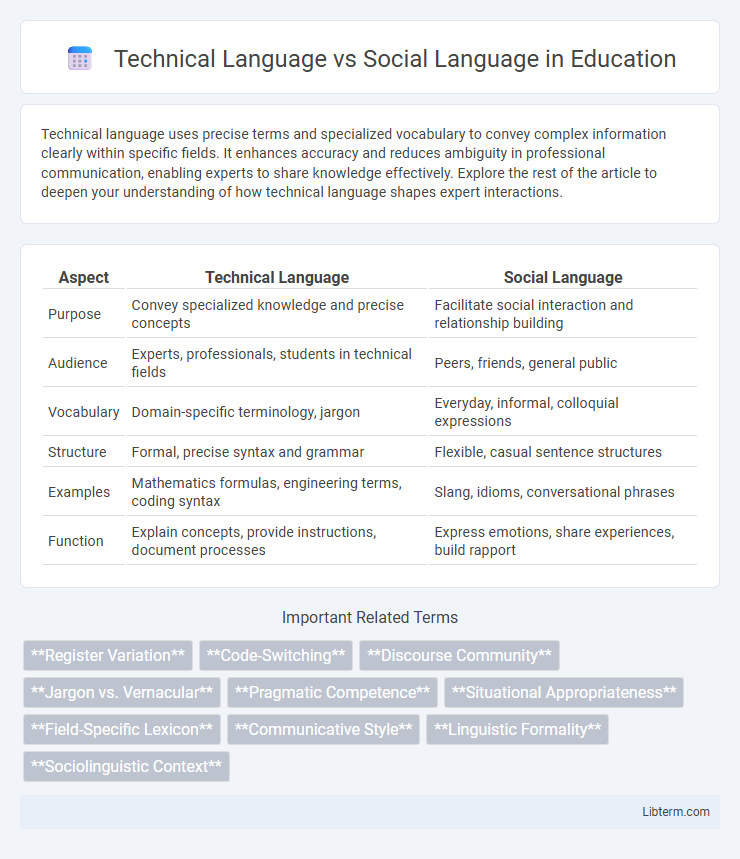Technical language uses precise terms and specialized vocabulary to convey complex information clearly within specific fields. It enhances accuracy and reduces ambiguity in professional communication, enabling experts to share knowledge effectively. Explore the rest of the article to deepen your understanding of how technical language shapes expert interactions.
Table of Comparison
| Aspect | Technical Language | Social Language |
|---|---|---|
| Purpose | Convey specialized knowledge and precise concepts | Facilitate social interaction and relationship building |
| Audience | Experts, professionals, students in technical fields | Peers, friends, general public |
| Vocabulary | Domain-specific terminology, jargon | Everyday, informal, colloquial expressions |
| Structure | Formal, precise syntax and grammar | Flexible, casual sentence structures |
| Examples | Mathematics formulas, engineering terms, coding syntax | Slang, idioms, conversational phrases |
| Function | Explain concepts, provide instructions, document processes | Express emotions, share experiences, build rapport |
Introduction to Technical and Social Language
Technical language consists of specialized vocabulary and terminology used within specific fields such as engineering, medicine, or information technology to convey precise and unambiguous information. Social language involves everyday communication that prioritizes relational and contextual understanding through informal expressions, slang, and conversational cues. Both forms of language serve distinct purposes: technical language facilitates clarity and accuracy in professional contexts, while social language enhances interpersonal connection and social interaction.
Defining Technical Language
Technical language consists of specialized vocabulary and jargon used within specific fields such as engineering, medicine, or computer science, designed to convey complex concepts precisely and efficiently. It prioritizes clarity, specificity, and accuracy to facilitate effective communication among professionals and experts. This language minimizes ambiguity by employing standardized terms and definitions unique to a discipline, enabling consistent understanding and reducing misinterpretation.
Defining Social Language
Social language encompasses the informal, everyday communication used to build relationships, express emotions, and navigate social interactions in various contexts. It involves pragmatic skills such as understanding tone, body language, and cultural norms, which are essential for effective interpersonal communication. Unlike technical language, social language prioritizes connection and mutual understanding over precision and specificity.
Key Differences Between Technical and Social Language
Technical language employs specialized vocabulary and precise terminology designed for clarity and efficiency in professional, scientific, or technological contexts, ensuring accurate communication among experts. Social language features informal expressions, colloquialisms, and context-dependent meanings that facilitate casual interaction and emotional connection in everyday social settings. The key differences lie in purpose, structure, and audience: technical language prioritizes accuracy and specificity for knowledge transfer, while social language emphasizes relatability and adaptability to social cues.
The Role of Context in Language Choice
Technical language is characterized by specialized terminology and precise expressions tailored to specific fields, ensuring clarity and accuracy within professional or academic contexts. Social language, in contrast, employs everyday vocabulary and informal structures designed to foster connection and mutual understanding in casual or interpersonal interactions. Context plays a crucial role in language choice, determining whether the communicative goal prioritizes technical accuracy or social engagement, thereby influencing vocabulary, tone, and complexity accordingly.
Impact of Technical Language in Professional Settings
Technical language enhances clarity and precision in professional settings by using domain-specific terminology that minimizes ambiguity and ensures accurate communication. Its impact includes improved efficiency in problem-solving and decision-making processes, as professionals can convey complex concepts succinctly. Relying on technical language also fosters credibility and authority within specialized fields, facilitating collaboration among experts.
Social Language in Everyday Communication
Social language in everyday communication is characterized by informal vocabulary, idiomatic expressions, and context-dependent meanings that facilitate personal connections and cultural understanding. It prioritizes empathy, tone, and non-verbal cues to enhance interaction and build rapport among individuals. Unlike technical language, social language adapts fluidly to different social settings, promoting inclusivity and relational dynamics.
Challenges of Switching Between Language Types
Switching between technical language and social language poses challenges such as adjusting vocabulary complexity and tone to match the audience's needs and expectations. Technical language requires precise, jargon-heavy expressions for clarity in specialized fields, while social language relies on informal, context-sensitive communication to foster relationships. Failure to navigate these differences can lead to misunderstandings, reduced engagement, and ineffective information transfer.
Strategies for Bridging the Language Gap
Technical language often features specialized terminology and precise definitions, creating barriers for non-experts in social contexts. Employing analogies, simplified explanations, and visual aids enhances comprehension by translating complex concepts into relatable terms. Encouraging active dialogue and feedback loops between experts and laypersons promotes mutual understanding and effective communication across diverse audiences.
The Importance of Balancing Technical and Social Language
Balancing technical and social language is crucial for effective communication in professional environments, ensuring clarity and engagement. Technical language delivers precise, domain-specific information necessary for expertise, while social language fosters collaboration and rapport among team members. Integrating both enhances understanding, promotes inclusivity, and drives productive interactions in diverse workplace settings.
Technical Language Infographic

 libterm.com
libterm.com